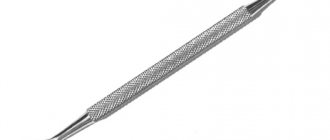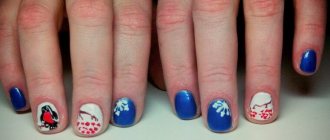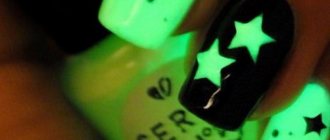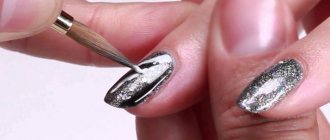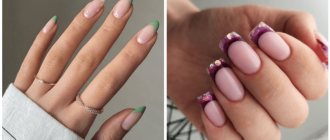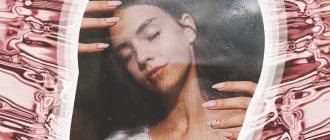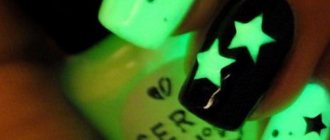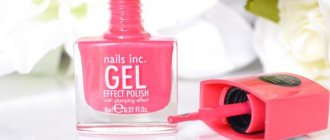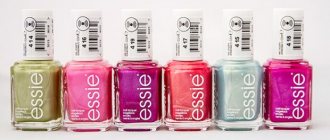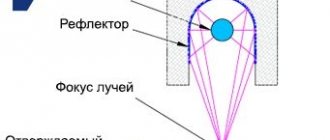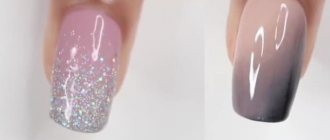Glowing nail polish that appears on store shelves raises many questions. Here are just a few of them: what are its varieties? Is its composition harmful? What if he's poisonous? How to apply it so that your nails glow like in the advertising brochure? How long will this varnish last and will there be any unpleasant surprises?
To answer all questions, you will have to start with the chemical composition. Often such varnishes are called phosphorus, they even use this word in the name. But phosphorus is banned due to its extremely high toxicity. How can this be? Simply, phosphors have been added to the varnish, which have a glow similar to phosphorus.
What are phosphors
This word has two roots: the Latin lumen, meaning “light,” and the ancient Greek φορός, which means “carrying.” This is what they decided to call substances that convert energy into light. The process of glowing of such a substance is called luminescence.
Inorganic phosphors are used in the production of lighting devices, TV screens, and in x-rays and fluorography. Organic lumogens are involved in the creation of paints for plastic, textiles, various decorations, and cosmetics. This type includes a special LDP pigment, which contains glow-in-the-dark varnish. It is non-toxic and non-radioactive. Its use in cosmetic materials is safe.
Under what conditions does the varnish glow?
LDP phosphor can accumulate light and release it only in a transparent environment, which is what determines its texture. If you mix luminous varnish with a dense color, wanting to give it brightness, there will be no effect. Therefore, when using LDP pigment independently, you should add it only to transparent formulations. And it can glow from three to twelve hours. The TAT33 pigment has a wider range of applications: it can be mixed with white gel for a French coat, and then release the accumulated light under artificial lighting and in the dark.
Both pigments in varnishes or gels do not show themselves in the light. On a white background, such varnish will be visible 50% longer than on a dark one. Like luminous varnishes, translucent materials of neon collections (regular, without phosphors) are also applied to a white substrate, so sometimes there is confusion in the names. They are called neon for their very similar glow, and not for their composition.
What happens if you try to brush the luminous pigment into the dispersion layer of gel polish? You will get a luminous layer. It is fixed with a top coat so that the pigment adheres well.
What is the name of reflective gel polish: review of brands
On foreign resources this varnish is called hanbi gel . You can find the product on Aliexpress. In the search engine, at the top you need to enter “reflective gel polish”, “varnish with a reflective effect”, “ hanbi gel” . Now a large number of sellers offer unusual options. If you don’t want to buy new bottles, you can buy pigment on AliExpress. It is rubbed into nails, or mixed with top or base. Russian and Ukrainian companies have released well-known lines.
Brands of reflective gel polish:
- Ellis Disco (silver 367, pink 368, gold 369)
- Oxxi Disco
- Braun
- NeoNail (6315-7, Shiny Rose)
- Serebro
- Saga;
- Ann.
- NR
- Fox
Some companies do not sell varnishes with reflective particles, but give them as a gift when purchasing goods for a certain amount.
How to “charge” glowing varnish
Phosphors accumulate direct light emitted by its source. Reflected light will not “charge” the varnish. In order to make the polish glow, enough daylight during the day. If you wish, before a party in a cafe where there will be artificial lighting, you can hold your nails to an incandescent lamp or an energy-saving lamp. After an hour-long “charging”, the varnish can glow very brightly for two hours. Then gradually the intensity will begin to decrease. Light green and blue varnishes shine the brightest.
How to make polish glow if it faded at a party? To do this, do not forget the principle of glow of phosphors. As soon as the exposure to direct rays ends, the glow process begins. It is impossible to accurately calculate the brightness of a manicure for a specific hour of the evening. Even when the room is light, but the nails are not exposed to sunlight or lamp light, “discharge” begins. Therefore, in this case, it is better to look for a light source and raise your hands to it.
The glow is especially visible at dusk.
Fluorescent varnishes and their difference from luminescent ones
At the disco, ultraviolet lights and neon lamps are turned on to create a festive atmosphere. This lighting makes varnishes with finely ground fluorite mineral shine. It reflects the light that hits it and shines very brightly in the twilight. Unlike luminescent varnishes, it does not glow in the dark.
During the day, such a manicure looks very bright - it reflects the light that hits its surface. And in the dim evening light it shines and sparkles. At a disco, under the light of ultraviolet lamps, it looks like luminescent: both are varnishes that glow in ultraviolet. But if the light is suddenly turned off, the fluorescent one stops glowing, unlike the phosphor varnish.
general information
All varnishes that have this characteristic - glowing in the dark - can be divided into two large groups - those that reflect light and those that give it away. If we are talking about reflective coatings, then they glow in a certain spectrum, reflecting it. Most often this spectrum is ultraviolet. Light-emitting coatings are charged by daylight even while in the bottle, and in the dark they give it off, thus glowing. The choice of varnish type depends on the intended scope of its use.
Varnishes of both types are produced by a large number of manufacturers, including well-known and status ones. They can have various markings on the bottle, characterizing their properties and the principle of luminescence. Some of these markings and the characteristics of the varnishes marked by them will be described below.
- Neon. This marking implies a reflective coating that glows in ultraviolet light. It will not shine anywhere else, and therefore is only good in a club setting. The shades of such coatings are most often very bright - fuchsia, lime and the like. Under ultraviolet light, the color most often remains unchanged, but begins to glow brightly. During daylight hours, the varnish is no different from its simple counterparts; it looks beautiful and catchy;
- Fluorescence, fluorescent varnish. It has all the same properties and characteristics as neon. It features an extremely narrow palette of shades. Some brands have such a line consisting of only four or five bright colors;
- Phosphorus, phosphorus nail polish. A coating containing compounds of this element is most often transparent or translucent with some shade and is applied directly over colored varnish. During the day, phosphorus accumulates light and releases it at night, glowing with a light green, yellowish or bluish tint (depending on the type of compound). The glow is even and quite intense, however, currently this type of coating is practically not used due to the fact that it contains harmful components that can damage the health of the nails and skin of the pre-nail ridges;
- Luminescent varnish is a kind of multifunctional coating. It glows well both in ultraviolet light and in complete darkness. One condition for its use is that in order to glow in complete darkness, this varnish must first be in a bright room for several minutes, absorbing the light. It doesn’t matter whether this lighting is artificial or natural;
- Luminophore is another type of mark placed on luminescent varnish. This is the name of the special compound included in this type of coating. It has nothing in common with phosphorus; it glows just as intensely, but much longer. The maximum glow is observed during the first hour after leaving the light for darkness. Complete extinction occurs only after six hours.
As for long-term manicure and extensions, glow-in-the-dark nail polish can also be used in such nail design options.
Luminophore is a completely safe, waterproof powder for nails that can be mixed with any material. [yandex2] [google2]
Phosphorescent varnishes and their differences from fluorescent varnishes
If the bottle says “phosphorus varnish”, you should look at the composition indicated on it. Most often it is strontium aluminate or zinc sulfide. These compounds are not phosphorus, but have a long glow cycle - like phosphorus. They glow in the dark, but in daylight they present a dense, slightly matte varnish.
It glows in the dark with a greenish-bluish light, accumulating energy during the daytime. It will not sparkle and sparkle during the day, like fluorescent varnish in the sun.
This happens because the varnishes have different compositions: for fluorescent ones, sodium isothiocyanate (yellow-green color) or rhodamine (red color) is used. These compounds have a short glow cycle and quickly return to a quiet state in the dark. Only constant exposure to ultraviolet light causes fluorescent varnish to glow.
Difficulties in applying gel polish with a reflective effect
There are several difficulties associated with applying reflective gel polishes. Basically, this is a loose coating due to the characteristics of the sparkle and the performance of the product.
Difficulties in applying gel polish with a reflective effect:
- As mentioned above, it is based on special hemispheres with a large number of edges. In order not to drown out their radiance and glow, translucent dyes and stained glass are added to the composition.
- Thanks to this, the coating turns out to be completely loose, unable to properly paint the area near the cuticle. In this case, you can do it in several ways. You can first apply a thick base from the flower bed, only then use reflective gel polish.
- After painting the first layer of reflective gel polish, using a thin brush, create a dense flower bed that matches the color of the reflective product. The second layer is covered with a reflective product. Thanks to this trick, the color of the cuticle will be more saturated and dense, beautifully delineating the border. This will allow you to create a popular cuticle coating, keeping your manicure looking fresh longer.
Review of popular brands and manufacturers of reflective gel polish
You can also see articles on similar topics here:
- Airbrush on nails
- Manicure according to Feng Shui
- Purple manicure
- How to do a manicure at home?
- What does hot manicure mean?
During the daytime, the coating looks like a regular color with glitter. At night, when light rays hit, small spheres inside the gel polish reflect it, causing a glow to appear.
Types and brands of varnishes
In the production of varnishes, phosphor pigment is now more often used. Brands of famous luminous varnishes:
- Domestic varnishes “Dance Legends” cost 200 rubles per 15 ml bottle. They are applied directly to the nail, as they contain a base. In the daytime they look like a dense color coating, some with shimmer. There are both light and dark tones. In the dark, the polish begins to glow and can change color: pink will turn green or blue, blue - green, coral - turquoise. These are the colors of the phosphors.
- Domestic varnish “Luminofor” costs 150 rubles per 11 ml bottle. Apply to a white backing. Three types of this varnish have different colors during the day: orange, white, transparent with a yellow-green tint. In the dark they glow yellow-orange, blue-green and yellow-green. When it enters the room from the street, a glow begins. You can charge the varnish from any lamp and from sunlight.
- The domestic brand “El Corazon” produces varnish with phosphors. A 16 ml bottle costs 179 rubles. Several dense colored varnishes glow in the dark with a greenish light.
- ISHOWTIENDA varnish, popular on major international online trading platforms. A 7 ml bottle costs from 80 to 100 rubles. After application, it turns your nails into small lanterns in the dark, reminiscent of fireflies. For a brighter glow, it is applied to a white substrate.
There are many other brands available for sale. It is difficult to determine their quality without seeing the composition. If the varnish contains radioactive light compounds with tritium, they should not be purchased. Harmless pigments are MHB-4E, MHP-6D and TAT 33.
Special effects for nails
Applying luminous varnish is no different from applying regular varnish. The only peculiarity is that if you use a luminescent coating, do not forget to “charge” it before leaving. You can paint the entire area of the nail with it, or you can highlight individual elements of the design, then they will shine in the dark. A French manicure looks beautiful when the base consists of regular varnish, and only the ends are covered with glowing varnish. They glow spectacularly in the dark. It will look no less beautiful if you apply a design to the nail with a dark varnish and a luminous one on top. If you're not afraid to stand out from others, try painting each fingernail a specific color.
Types and brands of gel polishes
Many brands have released glowing gel nail polishes. When purchasing them, you should choose well-known and respected brands to avoid purchasing low-quality products.
- Global Fashion neon gel polishes look bright during the day and glow in the evening. The cost of the bottle is 299 rubles.
- Gel polishes with phosphors Patrisa Nail, bottle capacity 8 ml. During the day it looks like a polish with glitter, in the evening the glitter begins to glow green. A bottle costs 340 rubles.
- Fluorescent gel polishes Rio Profi bottle volume 7 ml and cost 299 rubles. These dense rubber gels, in a variety of bright colors, glow green, blue or orange.
You can purchase glowing gel polish for a lower price on a large online site, but you should check for a quality certificate. Conscientious sellers undergo the certification procedure and always provide a copy of it along with the product.
How does the new reflective gel polish work?
Luminescent rubbing and colored pigments have been known for a long time. They have been used for more than 10 years, but the principle of their operation differs significantly from modern reflective gel polishes. Luminescent rubs or pigments have bright, acidic colors and glow when exposed to ultraviolet rays. In ordinary life, these are just bright pigments. They glow only when exposed to ultraviolet rays. Reflective gel polishes have a completely different structure and operating principle.
How the new reflective gel polish works:
- This principle was first used in 1939 and was used in the manufacture of paint for use on road signs. The glow principle is based on the use of special glass spheres with edges.
- When light hits these small spheres, it is refracted several times and comes out at the same angle. This results in a glowing effect. If you look at the gel polish itself, it looks like regular glitter products.
- However, these sparkles have the above structure, they are hemispheres with a large number of edges that refract and reflect light, causing a glow.
Pigment
